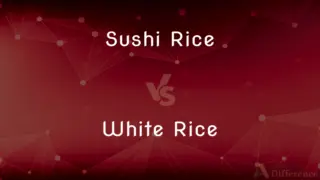Chilli vs. Chili — What's the Difference?
By Urooj Arif & Fiza Rafique — Updated on April 7, 2024
Chilli refers to the spicy fruit of the Capsicum plant, while chili denotes a stew made with chili peppers and meat, often including beans and tomatoes.

Difference Between Chilli and Chili
Table of Contents
ADVERTISEMENT
Key Differences
Chilli is the term commonly used in British English to refer to the hot, spicy pods from plants of the genus Capsicum, which are used to add heat to dishes. Whereas, chili in American English often refers to a spicy stew that contains chili peppers, meat, and sometimes beans and tomatoes. This culinary dish is especially popular in the Southwest of the United States.
Chilli peppers can vary significantly in their heat level, measured in Scoville Heat Units, and are used worldwide in cooking to add spiciness to food. On the other hand, chili as a dish incorporates these peppers for flavor, but the overall heat can be adjusted based on the type and amount of chili peppers used.
In terms of cultivation, chilli plants are grown in a variety of climates and are harvested for their fruits. Whereas, chili as a dish has evolved into many regional varieties, with recipes adapted to local tastes and available ingredients.
When discussing health benefits, chilli peppers are known for their high content of vitamins and compounds like capsaicin, which have antioxidant and anti-inflammatory properties. Conversely, chili, the dish, can be nutritious depending on its ingredients, offering a good source of protein, fiber, and vitamins if prepared with a balance of meat, beans, and vegetables.
Culturally, chilli has a significant place in many cuisines around the world, celebrated for its ability to enhance flavors and stimulate the senses. Chili, meanwhile, holds a special place in American cuisine, particularly in Texas, where it's considered a part of the state's cultural identity and even has an official state dish designation.
ADVERTISEMENT
Comparison Chart
Definition
Spicy fruit of the Capsicum plant.
A stew made with chili peppers, meat, beans, and tomatoes.
Usage
Ingredient in cooking to add heat.
A standalone dish.
Cultural Significance
Integral to various global cuisines.
Central to Southwestern and Texan cuisine.
Varieties
Numerous types with varying heat levels.
Multiple regional variations, ingredients, and heat levels.
Health Benefits
High in vitamins and capsaicin.
Nutritional value depends on ingredients.
Compare with Definitions
Chilli
Dietary Component.
Adding chilli to your diet can boost metabolism due to its capsaicin content.
Chili
Cultural Symbol.
In Texas, chili is more than just a dish; it's a cultural symbol with deep historical roots.
Chilli
Capsicum Pod.
The red chilli added a vibrant color and intense heat to the curry.
Chili
Cook-off Contest.
He entered his secret recipe in the local chili cook-off contest, hoping to win first place.
Chilli
Cultivation.
She cultivated several chilli varieties in her garden, ranging from mild to extremely hot.
Chili
Stew.
The slow-cooked chili simmered for hours, blending the flavors of meat, beans, and spices.
Chilli
Spice Source.
Ground chilli is used extensively to spice up sauces and marinades.
Chili
American Cuisine.
Chili con carne is a staple in American comfort food, especially loved during football season.
Chilli
Global Ingredient.
Chilli peppers are crucial in cuisines around the world, from Mexico to India.
Chili
Versatile Dish.
Vegetarian chili swaps meat for beans and lentils, offering a hearty but lighter option.
Chilli
A small hot-tasting pod of a variety of capsicum, used in sauces, relishes, and spice powders. There are various forms with pods of differing size, colour, and strength of flavour.
Chili
The pungent fresh or dried fruit of any of several cultivated varieties of capsicum, used especially as a flavoring in cooking. Also called chili pepper.
Chilli
Variant of chili.
Chili
A stew made of meat or beans (or both) and usually tomatoes, spiced with chili peppers or chili powder.
Chilli
Alternative spelling of chili
Chili
(countable) The pungent, spicy fresh or dried fruit of any of several cultivated varieties of capsicum peppers, used in cooking.
Chili pepper
Chilli
See Chili.
Chili
(uncountable) Powdered chili pepper, used as a spice or flavouring in cooking.
Chili powder
Chilli
Very hot and finely tapering pepper of special pungency
Chili
(Indian Chinese cuisine) A spicy stew of chicken or paneer, capsicum and onion, eaten as an appetizer.
Chili
A dish made with chili peppers and other ingredients, such as beans and beef.
Chili con carne
Chili
(Cincinnati) Cincinnati chili.
Chili
A kind of red pepper. See Capsicum
Chili
Ground beef and chili peppers or chili powder often with tomatoes and kidney beans
Chili
Very hot and finely tapering pepper of special pungency
Common Curiosities
What is chilli used for?
Chilli is primarily used as a spice or ingredient to add heat and flavor to dishes.
What makes chili a popular dish in the US?
Its versatility, rich flavor, and the tradition of chili cook-offs contribute to its popularity.
How does chili taste?
Chili's taste can range from mild to very spicy, incorporating savory, tangy, and sometimes sweet flavors depending on the recipe.
What's the difference between chili powder and chilli peppers?
Chili powder is a blend of ground chili peppers and other spices, whereas chilli peppers are the actual fruit.
Can chili be made without meat?
Yes, vegetarian chili versions use beans, lentils, or vegetables instead of meat.
Can chili be frozen?
Yes, chili freezes well and can be stored for future meals, making it convenient and economical.
How do you reduce the heat in chili?
Adding dairy products, like sour cream or cheese, can help mellow the heat in chili.
What's the best way to store chilli peppers?
Fresh chilli peppers should be stored in the refrigerator, while dried or powdered chilli can be kept in a cool, dry place.
Are all chilli peppers hot?
No, chilli pepper heat varies widely among species, from mild bell peppers to extremely hot habaneros.
Can chilli cause digestive issues?
For some people, eating too much chilli can lead to digestive discomfort due to its capsaicin content.
Is chilli healthy to eat?
Yes, chilli peppers are known for their health benefits, including vitamins, minerals, and capsaicin.
How many types of chilli are there?
There are hundreds of chilli varieties, each with unique flavors and heat levels.
Is chili an American invention?
While chili has roots in Native American cuisine, the dish as known today has been popularized in American culture.
Do chilli peppers get hotter as they age?
Yes, some chilli peppers can develop more heat as they ripen and change color.
Why is chili considered comfort food?
Its warmth, hearty ingredients, and the ability to be customized make chili a comforting and satisfying dish for many.
Share Your Discovery

Previous Comparison
Lorry vs. Truck
Next Comparison
Sequence vs. OrderAuthor Spotlight
Written by
Urooj ArifUrooj is a skilled content writer at Ask Difference, known for her exceptional ability to simplify complex topics into engaging and informative content. With a passion for research and a flair for clear, concise writing, she consistently delivers articles that resonate with our diverse audience.
Co-written by
Fiza RafiqueFiza Rafique is a skilled content writer at AskDifference.com, where she meticulously refines and enhances written pieces. Drawing from her vast editorial expertise, Fiza ensures clarity, accuracy, and precision in every article. Passionate about language, she continually seeks to elevate the quality of content for readers worldwide.















































